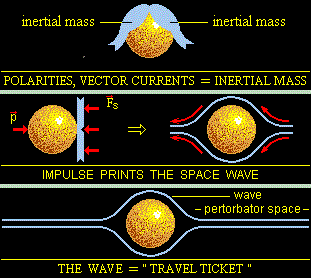The
movement logic in space
We analyze if the vacuum space has the ability to interact similar as
the air,
We notice that cosmic objects are moving gyroscopically, in elliptical
or circular orbits.
The stability of the movements, reveals that the vector space preserves
the interaction with the objects.
We say the objects move inertial.
Subjective
Inertial movement is a real phenomenon, taken as such, without attempting
to interpret.
The phenomenon is the interaction between two entities of vectorial nature
- object and space.
The inertia is manifest when the object moves and the space is fixed,
or when the object is fixed and the space is moving (gravity case).
In the first case, the object receives an impulse and that print a wave
in the space - the object is imponderable.
In the second case, the impulse is a fixed support force, and the movement
of space is print to the object, as the force called weight.
By removing the supporting force, the weight is the impulse that repeats
the first case - the object becomes imponderable.
So the "pact" of preserving the interaction is the wave.
The inertial rotation motion shows the ondulatory interaction of the vector
space,
by phenomenon of nutation and precession, irrespective of the mass of
the object.
Interpretation of inertial wave
Waves are attributes of the vectorial space, oscillations without loss
of energy.
The impulse applied to an object is an action that produces an equivalent
reaction of thespace.
The reaction of vectorial space are parallel currents (centripetal interactions)
that oscillates,
preserving movement after the action is stopped - inertial wave.
If the action does not stop (case two), the reaction is converted into
pressure (weight).
Conclusion:
Inertial wave is the consequence of the interaction of the vectorial space
with a vectorial structure.
Like any wave, the inertial wave oscillates without energy loss.
Mass
("God particle")
Vectorial space, the vectors, form orthogonal vector currents - matter.
The measure of the interaction of the vector space, with all the vectorial
currents of the matter (object, atom) is called mass.
Consequently, the mass is a relative size.
The vector structure of the object
The object can be monolithic, a structure of atoms, nucleons, closely
united by vectorial currents,
or spherical compressed gas, of centripetal vector interactions, as a
result of the rotational movement.


